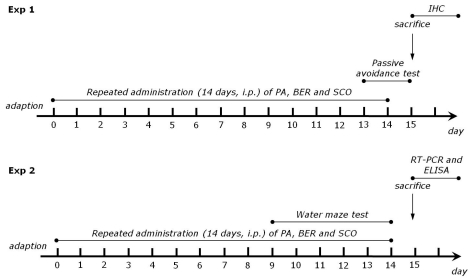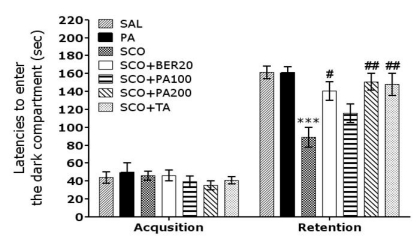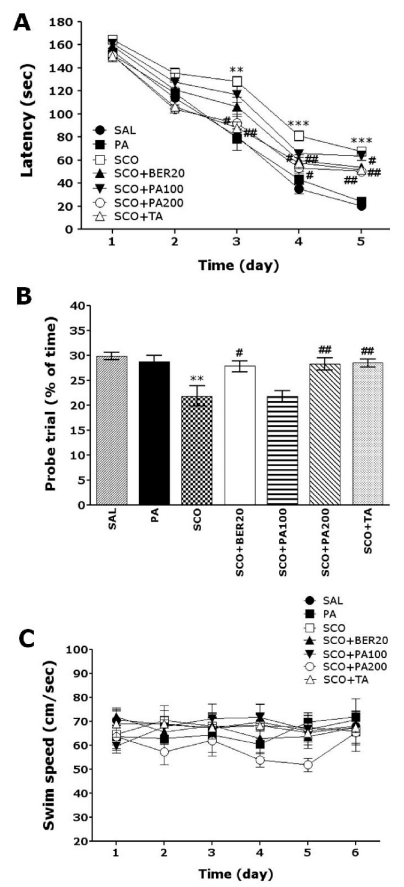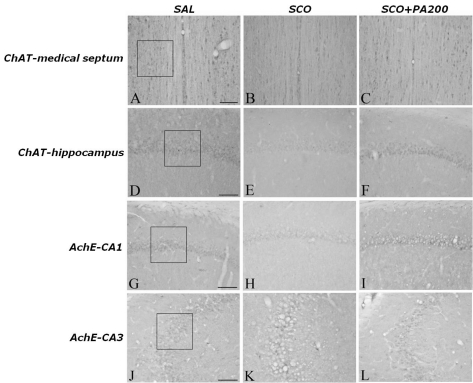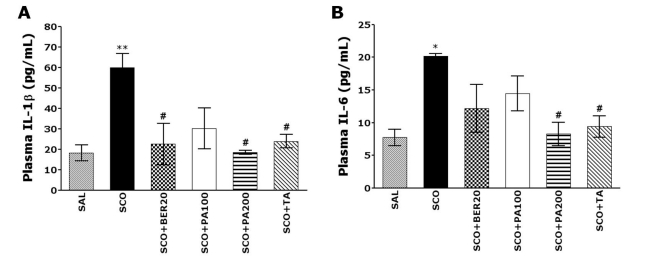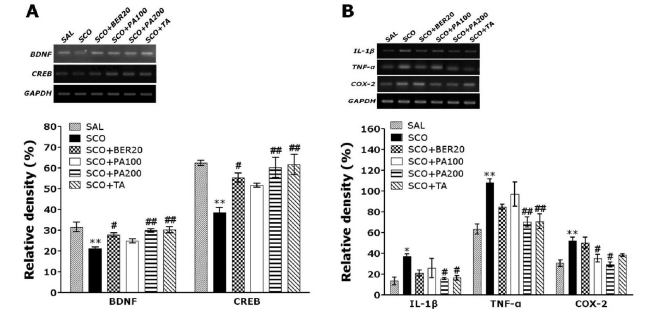Korean J Physiol Pharmacol.
2012 Apr;16(2):79-89. 10.4196/kjpp.2012.16.2.79.
Phellodendron amurense and Its Major Alkaloid Compound, Berberine Ameliorates Scopolamine-Induced Neuronal Impairment and Memory Dysfunction in Rats
- Affiliations
-
- 1Acupuncture and Meridian Science Research Center, College of Oriental Medicine, Kyung Hee University, Seoul 130-701, Korea. bombi@khu.ac.kr, dhhahm@khu.ac.kr
- 2The Graduate School of Basic Science of Oriental Medicine, College of Oriental Medicine, Kyung Hee University, Seoul 130-701, Korea.
- KMID: 2071752
- DOI: http://doi.org/10.4196/kjpp.2012.16.2.79
Abstract
- We examine whether Phellodendron amurense (PA) and its major alkaloid compound, berberine (BER), improved memory defects caused by administering scopolamine in rats. Effects of PA and BER on the acetylcholinergic system and pro-inflammatory cytokines in the hippocampus were also investigated. Male rats were administered daily doses for 14 days of PA (100 and 200 mg/kg, i.p.) and BER (20 mg/kg, i.p.) 30 min before scopolamine injection (2 mg/kg, i.p.). Daily administration of PA and BER improved memory impairment as measured by the passive avoidance test and reduced the escape latency for finding the platform in the Morris water maze test. Administration of PA and BER significantly alleviated memory-associated decreases in cholinergic immunoreactivity and restored brain-derived neurotrophic factor and cAMP-response element-binding protein mRNA expression in the hippocampus. PA and BER also decreased significantly the expression of proinflammatory cytokines such as interleukin-1beta, tumor necrosis factor-alpha and cyclooxygenase-2 mRNA in the hippocampus. These results demonstrated that PA and BER had significant neuroprotective effects against neuronal impairment and memory dysfunction caused by scopolamine in rats. These results suggest that PA and BER may be useful as therapeutic agents for improving cognitive functioning by stimulating cholinergic enzyme activity and alleviating inflammatory responses.
Keyword
MeSH Terms
-
Animals
Berberine
Brain-Derived Neurotrophic Factor
Cholinergic Neurons
Cyclooxygenase 2
Cytokines
Hippocampus
Humans
Interleukin-1beta
Male
Memory
Neurons
Neuroprotective Agents
Phellodendron
Rats
RNA, Messenger
Scopolamine Hydrobromide
Tumor Necrosis Factor-alpha
United Nations
Berberine
Brain-Derived Neurotrophic Factor
Cyclooxygenase 2
Cytokines
Interleukin-1beta
Neuroprotective Agents
RNA, Messenger
Scopolamine Hydrobromide
Tumor Necrosis Factor-alpha
Figure
Reference
-
1. Blennow K, de Leon MJ, Zetterberg H. Alzheimers disease. Lancet. 2006; 368:387–403. PMID: 16876668.
Article2. Hasselmo ME. The role of acetylcholine in learning and memory. Curr Opin Neurobiol. 2006; 16:710–715. PMID: 17011181.
Article3. Drever BD, Anderson WG, Johnson H, O'Callaghan M, Seo S, Choi DY, Riedel G, Platt B. Memantine acts as a cholinergic stimulant in the mouse hippocampus. J Alzheimers Dis. 2007; 12:319–333. PMID: 18198419.
Article4. Klinkenberg I, Blokland A. The validity of scopolamine as a pharmacological model for cognitive impairment: a review of animal behavioral studies. Neurosci Biobehav Rev. 2010; 34:1307–1350. PMID: 20398692.
Article5. Mohapel P, Leanza G, Kokaia M, Lindvall O. Forebrain acetylcholine regulates adult hippocampal neurogenesis and learning. Neurobiol Aging. 2005; 26:939–946. PMID: 15718053.
Article6. Solfrizzi V, D'Introno A, Colacicco AM, Capurso C, Todarello O, Pellicani V, Capurso SA, Pietrarossa G, Santamato V, Capurso A, Panza F. Circulating biomarkers of cognitive decline and dementia. Clin Chim Acta. 2006; 364:91–112. PMID: 16139826.
Article7. Viau S, Maire MA, Pasquis B, Grégoire S, Fourgeux C, Acar N, Bretillon L, Creuzot-Garcher CP, Joffre C. Time course of ocular surface and lacrimal gland changes in a new scopolamine-induced dry eye model. Graefes Arch Clin Exp Ophthalmol. 2008; 246:857–867. PMID: 18357464.
Article8. Wang JF, Wei DQ, Chou KC. Drug candidates from traditional chinese medicines. Curr Top Med Chem. 2008; 8:1656–1665. PMID: 19075772.
Article9. Hara H, Kataoka S, Anan M, Ueda A, Mutoh T, Tabira T. The therapeutic effects of the herbal medicine, Juzen-taiho-to, on amyloid-beta burden in a mouse model of Alzheimer's disease. J Alzheimers Dis. 2010; 20:427–439. PMID: 20164567.10. Park EK, Rhee HI, Jung HS, Ju SM, Lee YA, Lee SH, Hong SJ, Yang HI, Yoo MC, Kim KS. Antiinflammatory effects of a combined herbal preparation (RAH13) of Phellodendron amurense and Coptis chinensis in animal models of inflammation. Phytother Res. 2007; 21:746–750. PMID: 17450506.
Article11. Zhang J, Yang JQ, He BC, Zhou QX, Yu HR, Tang Y, Liu BZ. Berberine and total base from rhizoma coptis chinensis attenuate brain injury in an aluminum-induced rat model of neurodegenerative disease. Saudi Med J. 2009; 30:760–766. PMID: 19526156.12. Bhutada P, Mundhada Y, Bansod K, Tawari S, Patil S, Dixit P, Umathe S, Mundhada D. Protection of cholinergic and antioxidant system contributes to the effect of berberine ameliorating memory dysfunction in rat model of streptozotocin-induced diabetes. Behav Brain Res. 2011; 220:30–41. PMID: 21262264.
Article13. Zhu F, Qian C. Berberine chloride can ameliorate the spatial memory impairment and increase the expression of interleukin-1beta and inducible nitric oxide synthase in the rat model of Alzheimers disease. BMC Neurosci. 2006; 7:78. PMID: 17137520.
Article14. Hung TM, Dang NH, Kim JC, Jang HS, Ryoo SW, Lee JH, Choi JS, Bae K, Min BS. Alkaloids from roots of Stephania rotunda and their cholinesterase inhibitory activity. Planta Med. 2010; 76:1762–1764. PMID: 20391319.15. Lee BB, Chae YB, Kwon YK, Yang CH, Kim MR, Kim KJ, Hahm DH, Lee HJ, Shim IS. Inhibitory action of cortex phellodendris on nicotine-induced behavioral sensitization. Korean J Orient Physiol Pathol. 2004; 18:767–773.16. Shahidi S, Komaki A, Mahmoodi M, Atrvash N, Ghodrati M. Ascorbic acid supplementation could affect passive avoidance learning and memory in rat. Brain Res Bull. 2008; 76:109–113. PMID: 18395619.
Article17. Mohamed AF, Matsumoto K, Tabata K, Takayama H, Kitajima M, Watanabe H. Effects of Uncaria tomentosa total alkaloid and its components on experimental amnesia in mice: elucidation using the passive avoidance test. J Pharm Pharmacol. 2000; 52:1553–1561. PMID: 11197086.18. Paxinos G, Watson C. The rat brain in stereotaxic coordinates. 1986. New York: Academic Press.19. Taylor BM, Kolbasa KP, Chin JE, Richards IM, Fleming WE, Griffin RL, Fidler SF, Sun FF. Roles of adhesion molecules ICAM-1 and alpha4 integrin in antigen-induced changes in microvascular permeability associated with lung inflammation in sensitized brown Norway rats. Am J Respir Cell Mol Biol. 1997; 17:757–766. PMID: 9409563.20. Zhou HY, Wang D, Cui Z. Ferulates, amurenlactone A and amurenamide A from traditional Chinese medicine cortex Phellodendri Amurensis. J Asian Nat Prod Res. 2008; 10:409–413. PMID: 18464078.
Article21. Kulkarni SK, Dhir A. Berberine: a plant alkaloid with therapeutic potential for central nervous system disorders. Phytother Res. 2010; 24:317–324. PMID: 19998323.
Article22. Gu L, Li N, Gong J, Li Q, Zhu W, Li J. Berberine ameliorates intestinal epithelial tight-junction damage and down-regulates myosin light chain kinase pathways in a mouse model of endotoxinemia. J Infect Dis. 2011; 203:1602–1612. PMID: 21592990.
Article23. Jonasson Z. Meta-analysis of sex differences in rodent models of learning and memory: a review of behavioral and biological data. Neurosci Biobehav Rev. 2005; 28:811–825. PMID: 15642623.
Article24. Lee B, Park J, Kwon S, Park MW, Oh SM, Yeom MJ, Shim I, Lee HJ, Hahm DH. Effect of wild ginseng on scopolamine-induced acetylcholine depletion in the rat hippocampus. J Pharm Pharmacol. 2010; 62:263–271. PMID: 20487207.
Article25. Blokland A, Geraerts E, Been M. A detailed analysis of rats' spatial memory in a probe trial of a Morris task. Behav Brain Res. 2004; 154:71–75. PMID: 15302112.
Article26. Sharma D, Puri M, Tiwary AK, Singh N, Jaggi AS. Antiamnesic effect of stevioside in scopolamine-treated rats. Indian J Pharmacol. 2010; 42:164–167. PMID: 20871768.
Article27. Kotani S, Yamauchi T, Teramoto T, Ogura H. Pharmacological evidence of cholinergic involvement in adult hippocampal neurogenesis in rats. Neuroscience. 2006; 142:505–514. PMID: 16889901.
Article28. Kumar R, Jaggi AS, Singh N. Effects of erythropoietin on memory deficits and brain oxidative stress in the mouse models of dementia. Korean J Physiol Pharmacol. 2010; 14:345–352. PMID: 21165335.
Article29. Giacobini E. Long-term stabilizing effect of cholinesterase inhibitors in the therapy of Alzheimer' disease. J Neural Transm Suppl. 2002; 62:181–187. PMID: 12456062.
Article30. Wei J, Lu DX, Qi RB, Wang HD, Jiang XH. Effect of Kangshuai Yizhi Formula I on learning and memory dysfunction induced by scopolamine in mice. Chin J Integr Med. 2010; 16:252–257. PMID: 20694781.31. Counts SE, He B, Che S, Ginsberg SD, Mufson EJ. Galanin hyperinnervation upregulates choline acetyltransferase expression in cholinergic basal forebrain neurons in Alzheimer's disease. Neurodegener Dis. 2008; 5:228–231. PMID: 18322398.
Article32. Williams CM, El Mohsen MA, Vauzour D, Rendeiro C, Butler LT, Ellis JA, Whiteman M, Spencer JP. Blueberry-induced changes in spatial working memory correlate with changes in hippocampal CREB phosphorylation and brain-derived neurotrophic factor (BDNF) levels. Free Radic Biol Med. 2008; 45:295–305. PMID: 18457678.
Article33. Vaynman S, Ying Z, Gomez-Pinilla F. Interplay between brain-derived neurotrophic factor and signal transduction modulators in the regulation of the effects of exercise on synaptic-plasticity. Neuroscience. 2003; 122:647–657. PMID: 14622908.
Article34. Kida S, Josselyn SA, Peña de Ortiz S, Kogan JH, Chevere I, Masushige S, Silva AJ. CREB required for the stability of new and reactivated fear memories. Nat Neurosci. 2002; 5:348–355. PMID: 11889468.
Article35. Guzowski JF, McGaugh JL. Antisense oligodeoxynucleotide-mediated disruption of hippocampal cAMP response element binding protein levels impairs consolidation of memory for water maze training. Proc Natl Acad Sci USA. 1997; 94:2693–2698. PMID: 9122258.
Article36. Tyler WJ, Alonso M, Bramham CR, Pozzo-Miller LD. From acquisition to consolidation: on the role of brain-derived neurotrophic factor signaling in hippocampal-dependent learning. Learn Mem. 2002; 9:224–237. PMID: 12359832.
Article37. Xu J, Rong S, Xie B, Sun Z, Deng Q, Wu H, Bao W, Wang D, Yao P, Huang F, Liu L. Memory impairment in cognitively impaired aged rats associated with decreased hippocampal CREB phosphorylation: reversal by procyanidins extracted from the lotus seedpod. J Gerontol A Biol Sci Med Sci. 2010; 65:933–940. PMID: 20530246.
Article38. Hong SW, Yang JH, Joh EH, Kim HJ, Kim DH. Gypenoside TN-2 ameliorates scopolamine-induced learning deficit in mice. J Ethnopharmacol. 2011; 134:1010–1013. PMID: 21333723.
Article39. Xue W, Hu JF, Yuan YH, Sun JD, Li BY, Zhang DM, Li CJ, Chen NH. Polygalasaponin XXXII from Polygala tenuifolia root improves hippocampal-dependent learning and memory. Acta Pharmacol Sin. 2009; 30:1211–1219. PMID: 19684611.
Article40. Dickson DW, Lee SC, Mattiace LA, Yen SH, Brosnan C. Microglia and cytokines in neurological disease, with special reference to AIDS and Alzheimer's disease. Glia. 1993; 7:75–83. PMID: 8423065.
Article41. Eikelenboom P, Zhan SS, van Gool WA, Allsop D. Inflammatory mechanisms in Alzheimer's disease. Trends Pharmacol Sci. 1994; 15:447–450. PMID: 7886816.
Article42. Rothwell N, Allan S, Toulmond S. The role of interleukin 1 in acute neurodegeneration and stroke: pathophysiological and therapeutic implications. J Clin Invest. 1997; 100:2648–2652. PMID: 9389726.
Article43. Fehér A, Juhász A, Rimanóczy A, Kálmán J, Janka Z. Association study of interferon-γ, cytosolic phospholipase A2, and cyclooxygenase-2 gene polymorphisms in Alzheimer disease. Am J Geriatr Psychiatry. 2010; 18:983–987. PMID: 20808133.
Article44. Fujimi K, Noda K, Sasaki K, Wakisaka Y, Tanizaki Y, Iida M, Kiyohara Y, Kanba S, Iwaki T. Altered expression of COX-2 in subdivisions of the hippocampus during aging and in Alzheimer's disease: the Hisayama Study. Dement Geriatr Cogn Disord. 2007; 23:423–431. PMID: 17457030.
Article
- Full Text Links
- Actions
-
Cited
- CITED
-
- Close
- Share
- Similar articles
-
- Treadmill Exercise Ameliorates Short-Term Memory Disturbance in Scopolamine-Induced Amnesia Rats
- Inhibitory Effects of Isoquinoline Alkaloid Berberine on Ischemia-Induced Apoptosis via Activation of Phosphoinositide 3-Kinase/Protein Kinase B Signaling Pathway
- Berberine Ameliorates Brain Inflammation in Poloxamer 407-Induced Hyperlipidemic Rats
- The Effect of Glycopyrrolate (Robinul) on Scopolamine Induced Bradycardia
- Effect of Berberine on Cell Survival in the Developing Rat Brain Damaged by MK-801

